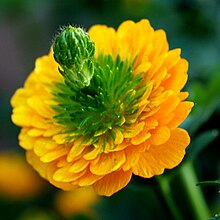
Virescence is the abnormal development of green pigmentation in plant parts that are not normally green, like shoots or flowers (in which case it is known as floral virescence).[1] Virescence is closely associated with phyllody (the abnormal development of flower parts into leaves) and witch's broom (the abnormal growth of a dense mass of shoots from a single point). They are often symptoms of the same disease affecting the plants, typically those caused by phytoplasmas.[2] The term chloranthy is also sometimes used for floral virescence, though it is more commonly used for phyllody.[3]
The term was coined around 1825, from Latin virescere, "to become green". In the English language the term virescent may also refer to greenness (cf. verdant).[4]